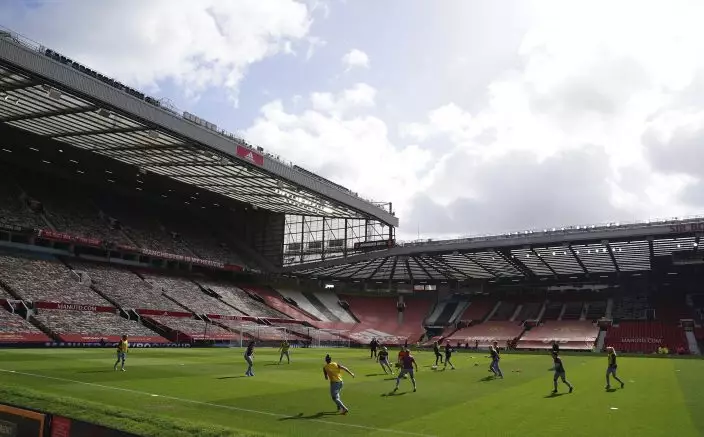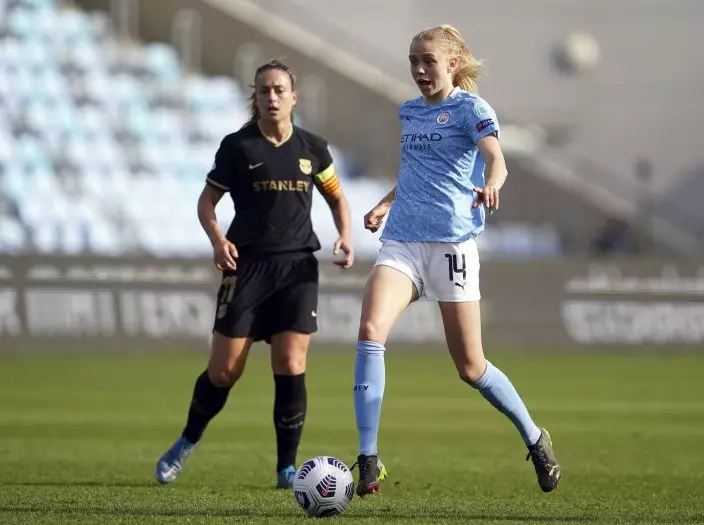To assess the progress achieved by the Women's Super League, Kelly Simmons first reflects on the state of play before the competition started exactly a decade ago.
The development of competitive women's football was blocked in England by a ban that existed for 50 years until being overturned by The Football Association in 1971. It took the FA's investment and the determination of Simmons to drive the creation of the WSL in 2011.
“The women’s game at the top level was similar to a grassroots structure in the sense that players were amateur and the clubs were run by volunteers," said Simmons, the FA's director of professional women's football.

A general view as players warm up before the Women's Super League match between Manchester United and West Ham United at Old Trafford, Manchester, England, Saturday, March 27, 2021. The Manchester United women’s team has made its Old Trafford debut in a league game against West Ham. The team normally plays its Women’s Super League home matches at Leigh Sports Village but switched to Old Trafford during the international break in the men’s game. (Zac GoodwinPA via AP)
What began 10 years ago on Tuesday with eight semiprofessional sides has expanded since 2018 to be Europe’s only fully professional women’s league with 12 teams.
Professionalization has seen standards raised — from the quality of pitches and coaching to marketing and television exposure. Barclays came on board as the title sponsor in 2019 and cash will be generated from television rights in Britain for the first time next season — along with increased exposure — when the BBC and Sky start showing games live as part of a three-year deal worth around $30 million.
The WSL's revenue is dwarfed by the billions generated each year by the Premier League but that competition had a two-decade head start along with the men's game benefiting from disproportionate levels of spending and interest from sponsors, broadcasters and fans.

Manchester United's Ella Toone, right, and West Ham United's Cecilie Redisch Kvamme battle for the ball during the Women's Super League match at Old Trafford, Manchester, England, Saturday, March 27, 2021. The Manchester United women’s team has made its Old Trafford debut in a league game against West Ham. The team normally plays its Women’s Super League home matches at Leigh Sports Village but switched to Old Trafford during the international break in the men’s game. (Zac GoodwinPA via AP)
Before the pandemic mostly shut stadiums to fans in March 2020, the WSL saw attendances rise on the back of England's run to a third consecutive tournament semifinal at the 2019 World Cup. With clubs starting to use their main stadiums more for women's teams, Tottenham attracted a WSL-record crowd of 38,262 for a north London derby against Arsenal in 2019.
Investment in women's football from the Premier League's most successful teams has enabled the WSL to attract leading players.
Chelsea spent around 300,000 euros (about $350,000) last year to sign Denmark international Pernille Harder to break the global women's transfer record. While winning the WSL last season, the women's football side of the Roman Abramovich-owned club lost 1.8 million pounds ($2.47 million) and was subsidized by loans of 4.2 million pounds from within the Stamford Bridge setup.

Barcelona's Alexia Putellas, left, and Manchester City's Esme Morgan battle for the ball during the Women's Champions League match between Manchester City Women and Barcelona Femenino at the Manchester City Academy Stadium, Manchester, England, Wednesday, March 31, 2021. (Zac GoodwinPA via AP)
Simmons thinks it could be another decade until women's teams are self-sustainable, particularly as they spend to attract top talent. Chelsea has also brought in Australia striker Sam Kerr while Manchester United added World Cup winners Tobin Heath and Christen Press last year and Manchester City signed their fellow Americans Rose Lavelle and Sam Mewis.
“The player salaries potentially are going to increase because there’s more competition with the growth of European leagues,” Simmons said. “Ultimately our vision is we want the best women’s league in the world. Of course, to get that we have got to invest in the short term, but you’ve got to make it sustainable. We’ve got to grow enough revenue to ultimately make it sustainable. That will take some time."
For now, the National Women’s Soccer League in the United States is one of the WSL's main rivals with Spain due to launch Europe's second fully professional women's league next season.
“Professional employment opportunities for players in stable conditions are essential for the long-term success and sustainability of the global women’s football industry,” world players' union FIFPRO said.
That is why the FA is so willing to assist other countries, including Japan and Portugal recently, on growing their women's competitions.
“It will become tougher as more professional leagues grow to attract the world’s top players," Simmons said. “And that’s why we can’t stand still.”
Particularly when there are challenges still back in England in ensuring the training and living standards provided by clubs befit professional players.
Birmingham's squad complained recently to the club's leadership about salaries and working conditions, including delays over treatment for injured players, a lack of access to the training-ground gym and changing rooms and travel arrangements for away fixtures.
“For a club of Birmingham’s stature, to be playing in the WSL, it’s not OK for players to be experiencing what they are,” said former Birmingham striker Ellen White, who now plays for Manchester City. “I think it’s important that it’s been brought to attention, and something needs to be done, especially with them having been in the WSL from pretty much the start.”
Simmons and her FA colleagues are in discussions with Birmingham about a resolution to a situation that underscores why the WSL is remaining at 12 teams for now.
“What we’ve got to do is make sure that it grows without diluting the quality of the product that we’ve got,” Simmons said. "Obviously, the more teams we have the more it dilutes central revenues that are being distributed to support them.
“With COVID as well, it’s really hard. We don’t know what the true impacts of COVID are in any industry yet. I think it would be high risk to expand too early.”
More AP soccer: https://apnews.com/hub/soccer and https://twitter.com/AP_Sports


